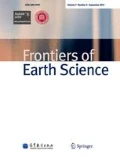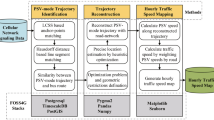Abstract
It is a pressing task to estimate the real-time travel time on road networks reliably in big cities, even though floating car data has been widely used to reflect the real traffic. Currently floating car data are mainly used to estimate the real-time traffic conditions on road segments, and has done little for turn delay estimation. However, turn delays on road intersections contribute significantly to the overall travel time on road networks in modern cities. In this paper, we present a technical framework to calculate the turn delays on road networks with float car data. First, the original floating car data collected with GPS equipped taxies was cleaned and matched to a street map with a distributed system based on Hadoop and MongoDB. Secondly, the refined trajectory data set was distributed among 96 time intervals (from 0: 00 to 23: 59). All of the intersections where the trajectories passed were connected with the trajectory segments, and constituted an experiment sample, while the intersections on arterial streets were specially selected to form another experiment sample. Thirdly, a principal curve-based algorithm was presented to estimate the turn delays at the given intersections. The algorithm argued is not only statistically fitted the real traffic conditions, but also is insensitive to data sparseness and missing data problems, which currently are almost inevitable with the widely used floating car data collecting technology. We adopted the floating car data collected from March to June in Beijing city in 2011, which contains more than 2.6 million trajectories generated from about 20000 GPS-equipped taxicabs and accounts for about 600 GB in data volume. The result shows the principal curve based algorithm we presented takes precedence over traditional methods, such as mean and median based approaches, and holds a higher estimation accuracy (about 10%–15% higher in RMSE), as well as reflecting the changing trend of traffic congestion. With the estimation result for the travel delay at intersections, we analyzed the spatio-temporal distribution of turn delays in three time scenarios (0: 00–0: 15, 8: 15–8: 30 and 12: 00–12: 15). It indicates that during one’s single trip in Beijing, average 60% of the travel time on the road networks is wasted on the intersections, and this situation is even worse in daytime. Although the 400 main intersections take only 2.7% of all the intersections, they occupy about 18% travel time.
Similar content being viewed by others
References
Ban X J, Herring R, Hao P, Bayen A M (2009). Delay pattern estimation for signalized intersections using sampled travel times. Transport Res Rec, 2130(1): 109–119
Bejan A, Gibbens R, Evans D, Beresford A, Bacon J, Friday A (2010). Statistical modelling and analysis of sparse bus probe data in urban areas. In:13th International IEEE Conference on Intelligent Transportation Systems (ITSC), September 19–22, Madeira Island, Portugal, 1256–1263
Boyce D E, Kirson A, Schofer J L (1991). Design and implementation of ADVANCE: the Illinois dynamic navigation and route guidance demonstration program. In: IEEE Vehicle Navigation and Information Systems Conference(VNIS’91), October 20–23, Dearborn, Michigan, United States, 2: 415–426
Cheu R L, Xie C, Lee D (2002). Probe vehicles population and sample size for arterial speed estimation. Comput-Aided Civ Inf, 17(1): 53–60
Chodorow K, Dirolf M (2010). MongoDB: The Definitive Guide. Sebastopol, O’Reilly Media, Inc
Cowan K, Gates G (2002). Floating Vehicle Data system-realisation of a commercial system. In: 11th International Conference on Road Transport Information and Control, March 19–21, London, the United Kingdom, 87–189
Fabritiis C D, Ragona R, Valenti G (2008). Traffic estimation and prediction based on real time floating car data. In: 11th International IEEE Conference on Intelligent Transportation Systems, October 12–15, Beijing, China, 197–203
Ghaffarian H, Fathy M, Soryani M (2012). Vehicular ad hoc networks enabled traffic controller for removing traffic lights in isolated intersections based on integer linear programming. Iet Intell Transp Sy, 6(2): 115–123
Gühnemann A, Schäfer R P, Thiessenhusen K U, Wagner P. (2004). Monitoring traffic and emissions by floating car data. Institute of Transport Studies Working Paper, Issue ITS-WP-04-07, Sydney, Australia
Hastie T, Stuetzle W (1989). Principal curves. J Am Stat Assoc, 84(406): 502–516
Heidemann D (1994). Queue length and delay distributions at traffic signals. Transport Res B—Meth, 28(5): 377–389
Hellinga B R, Fu L (2002). Reducing bias in probe-based arterial link travel time estimates. Transport Res C—Emer, 10(4): 257–273
Herrera J, Work D, Herring R, Ban X J, Jacobson Q, Bayen A M (2010). Evaluation of traffic data obtained via GPS-enabled mobile phones: the Mobile Century field experiment. Transport Res C—Emer, 18(4): 568–583
Herring R, Hofleitner A, Abbeel P, Bayen A (2010). Estimating arterial traffic conditions using sparse probe data. In: Proceedings of the 13th International IEEE Conference on Intelligent Transportation Systems, September 19–22, Madeira Island, Portugal, 929–936
Homburger W S, Hall J W, William R R, Edward C S, Michelle D, Loretta H, John J L, Matthew R, Vernon H W (2007). Fundamentals of traffic engineering. University of California, Berkeley, Institute of Transportation Studies
Hong J, Zhang X, Wei Z, Li L, Yong R (2007). Spatial and temporal analysis of probe vehicle-based sampling for real-time traffic information system. In: Proceedings of the 2007 IEEE Intelligent Vehicles Symposium, June 13–15, 2007, Istanbul, Turkey, 13–15
Hunter T, Herring R, Abbeel P, Bayen A (2009). Path and travel time inference from GPS probe vehicle data. In: NIPS Analyzing Networks and Learning with Graphs, December 7–10, British Columbia, Canada
Kothuri S M, Tufte K A, Fayed E, Robert L B (2008). Toward understanding and reducing errors in real-time estimation of travel times. Transport Res Rec, (2049): 21–28
Kwong K, Kavaler R, Rajagopal R, Varaiya P (2009). Arterial travel time estimation based on vehicle re-identification using wireless magnetic sensors. Transport Res C—Emer, 17(6): 586–606
Li R, Rose G (2011). Incorporating uncertainty into short-term travel time predictions. Transport Res C—Emer, 19(6): 1006–1018
Liu H X, Ma W, Wu X, Hu H (2012). Real-time estimation of arterial travel time under congested conditions. Transportmetrica, 8(2): 87–104
Long J, Gao Z, Zhao X, Lian A, Orenstein P (2011). Urban traffic jam simulation based on the cell transmission model. Netw Spat Econ, 11(1): 43–64
Lou Y, Zhang C Y, Zheng Y, Xie X, Wang W, Huang Y (2009). Mapmatching for low-sampling-rate GPS trajectories. In: Proceedings of the 17th ACM SIGSPATIAL International Conference on Advances in Geographic Information Systems. Seattle, Washington, 352–361
Lu C (2010). A travel time estimation for planning models considering signalized intersections. ITE J, 80(10): 34–39
Nielsen O A, Frederiksen R D, Simonsen N (1998). Using expert system rules to establish data for intersections and turns in road networks. Int Trans Oper Res, 5(6): 569–581
Skabardonis A, Geroliminis N (2005). Real-time estimation of travel times on signalized arterials. In: Hani S M, ed. Transportation and Traffic Theory. Flow, Dynamics and Human Interaction. 16th International Symposium on Transportation and Traffic Theory, July 19–21, College Park Maryland, United States, 387–406
Sun L (2007). An approach for intersection delay estimate based on floating vehicles. Dissertation for Ph.D. Degree. Beijing: Beijing University of Technology (in Chinese)
Wang Z (2004). Using floating cars to measure travel time delay: How accurate is the method? Transport Res Rec, 1870(1): 84–93
White T (2010). Hadoop: The Definitive Guide. Sebastopol: Yahoo Press, O’Reilly Media, Inc
Winter S (2002). Modeling costs of turns in route planning. GeoInformatica, 6(4): 345–361
Xie X, Cheu R L, Lee D H (2001). Calibration-free arterial link speed estimation model using loop data. J Transp Eng, 127(6): 507–514
Xiong J, Liu J, Guan J, Sun J, Liu X, Wen H (2010). The minimum sample size determination of floating car in Beijing expressway. J Transp Syst Eng Inf Technol, 4: 38–43 (in Chinese)
Zhang H C, Lu F, Zhou L, Duan Y Y (2011). Computing turn delay in city road network with GPS collected trajectories. In: Proceedings of the 2011 International Workshop on Trajectory Data Mining and Analysis. September 17–21, Beijing, China, ACM, 45–52
Zhang J P, Wang J (2003). An overview of principal curves. Chinese Journal of Computers, 26(2): 129–146 (in Chinese)
Zheng N B, Lu F, Duan Y Y (2010). Dynamic dual graph model for turn delays on road networks. Journal of Image and Graphics, 15(6): 915–920 (in Chinese)
Zheng Y, Zhou X F (2011). Computing with Spatial Trajectories. New York: Springer-Verlag
Author information
Authors and Affiliations
Corresponding author
Additional information
Xiliang Liu obtained his B.S. degree in land resources management in Tongji University, China, 2007 and M.S. degree in geographic information engineering in China University of Mining & Technology (Beijing), China, 2011. Now he is a Ph.D. candidate in geographic information system in the Institute of Geographic Sciences and Natural Resources Research, Chinese Academy of Sciences. His current research interests mainly focus on trajectory data mining and intersection delay estimation.
Dr. Feng Lu is a Professor of Institute of Geographical Sciences and Natural Resources Research, Chinese Academy of Sciences. He received his B.S. degree from Wuhan University and Ph.D. degree from Institute of Remote Sensing Applications, Chinese Academy of Sciences. He is the Deputy Director of State Key Laboratory of Resources and Environmental Information System, a guest Ph.D. Advisor for the Fuzhou University, a member of the Information Technology Committee of Chinese Transportation Association, a member of the Theory and Methodology Committee of the Chinese Association of GIS and a member of the New Technology Applications Committee of Chinese City Planning Association. Dr. Lu’s research interests cover spatial data modeling, spatial DBMS, trajectory data mining, GIS for transportation and urban GIS application. During the past years, he has published over 120 referred journal and conference papers.
Hengcai Zhang received his B.S. degree in geographic science from Shandong Normal University and M.S. degree in cartography and geographic information system from Capital Normal University. Now he is a Ph.D. student from Institute of Geographical Sciences and Natural Resources Research, Chinese Academy of Sciences. His interests focus on moving objects database and spatial-temporal data mining.
Peiyuan Qiu received the B.S. degree in geographic science from Qingdao University, China in 2009 and the M. E. degree in cartography and geographic information engineering from Beijing University of Civil Engineering and Architecture, China in 2012. He is currently a Ph.D. candidate in Institute of Geographic Sciences and Natural Resources Research, Chinese Academy of Sciences. His current research interests focus on geographic semantics and trajectory mining.
Rights and permissions
About this article
Cite this article
Liu, X., Lu, F., Zhang, H. et al. Intersection delay estimation from floating car data via principal curves: a case study on Beijing’s road network. Front. Earth Sci. 7, 206–216 (2013). https://doi.org/10.1007/s11707-012-0350-y
Received:
Accepted:
Published:
Issue Date:
DOI: https://doi.org/10.1007/s11707-012-0350-y




